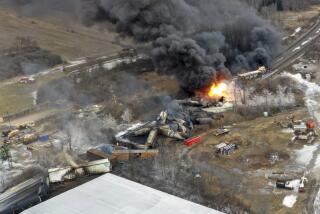We Can Engineer Safer World if We Will
- Share via
Accidents such as the explosion of the space shuttle, the disasters at Chernobyl and Bhopal, the crash of DC-10s due to the faulty design of a cargo door and the burn deaths due to the design of the Ford Pinto gas tank have raised questions in the public mind about whether engineers give sufficient attention to safety.
Closer examination shows that engineers often attempt to bring risks to light, but without success. The investigation of the space-shuttle accident has revealed that an engineer for Morton Thiokol Inc., the shuttle’s solid-rocket manufacturer, warned National Aeronautics and Space Administration officials last November that the backup O-ring seal on the booster would fail in cold weather. Engineers warned that the Pinto gas tank was likely to explode on impact. The safety of the Chernobyl nuclear-power plant had been criticized in Soviet technical journals.
Engineering students are often told that safety is their responsibility. “First make sure the system doesn’t do what you don’t want it to do--that’s the safety issue--then make sure it does do what you want it to do--that’s the performance issue.” These terms are remarkably similar to the admonition to physicians: “First do no harm.”
But is the responsibility for safety something that engineers are in a position to carry out? Unlike the majority of physicians, most engineers have no private practice. Instead, they work exclusively as employees, and they frequently do not have final authority within their organizations on how to reduce the risks to health and safety that their education has prepared them to recognize. Engineering students often assume that the responses of their future organizations will be fixed, so that their choices are either to keep quiet to keep the job, or blow the whistle and be fired and perhaps blacklisted. In my observation, many graduating engineering students are resigned to being unable to protect public health and safety as their professional codes enjoin them to do. The problem is not to be remedied simply by teaching engineering students how to work for change within organizations. There must also be broad support for individuals with the knowledge to foresee dangers to the health and safety of the public.
In addition to firms that have made their top managements accessible to engineers who voice safety concerns, several engineering societies have been active in providing support for individual engineers who find that their companies are not responsive. Notable in this area has been the Institute of Electrical and Electronic Engineers. Through entities such as its Member Conduct Committee, this society has provided some support to its members who are involved in disputes over issues of safety. But only to a certain extent. Members in California formed an organization called the Legal Defense Service to provide legal assistance to colleagues involved in whistle-blowing and similar disputes. The charter was approved by the institute’s San Francisco Bay Area Council but vetoed by the organization’s Executive Committee, in part because of the legal liability that the institute might incur.
Beyond reporting safety problems in the late stages of design, there is now a call for more attention to safety in the initial design of products and processes--for example, shuttle rockets that are safe through a greater range of temperatures, or nuclear-power plants that are designed, built and maintained to the high safety standards used in certain Western European nations. Engineering schools are putting more emphasis on safety, and the engineering societies are putting more emphasis on safety considerations in the design of both devices and processes. For example, the American Institute of Chemical Engineers has recently formed a Center for Process Safety to help prevent accidents such as happened at Bhopal.
In the case of newer techniques, the safety problem is compounded by the difficulty in predicting or coping with the consequences of an accident. The radiation exposure from the Chernobyl disaster is a case in point. Is it reasonable to employ a technology when we are unable to cope with an accident, and so must demand infallibility of design?
Beyond the question of accidents, we face other grave risks to health and safety. Among these is the widespread problem of groundwater contamination from hazardous wastes, which are produced in the United States at the startling rate of one ton per person per year. Such unintended consequences of technological development show that not only must devices operate safely in their intended uses, but that also the design of products and processes must take account of larger issues. This requires enlarging the domain of matters that an engineer is expected to consider in developing designs.
If we as a society expect this effort to “expand the problem space” of the engineer to bear fruit, more support will be needed for engineers who conscientiously try to fulfill the expanded responsibilities.






